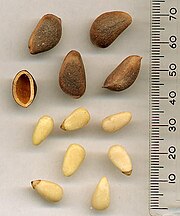From Wikipedia, the free encyclopedia

Stone Pine cone with pine nuts - note two nuts under each cone scale
| |
Species and geographic spread
In Europe, pine nuts come from the Stone Pine (Pinus pinea), which has been cultivated for its nuts for over 6,000 years, and harvested from wild trees for far longer. The Swiss Pine (Pinus cembra) is also used to a very small extent.In Asia, two species are widely harvested, Korean Pine (Pinus koraiensis) in northeast Asia (the most important species in international trade), and Chilgoza Pine (Pinus gerardiana) in the western Himalaya. Four other species, Siberian Pine (Pinus sibirica), Siberian Dwarf Pine (Pinus pumila), Chinese White Pine (Pinus armandii) and Lacebark Pine (Pinus bungeana), are also used to a lesser extent.
In North America, the main species are three of the pinyon pines, Colorado Pinyon (Pinus edulis), Single-leaf Pinyon (Pinus monophylla), and Mexican Pinyon (Pinus cembroides). The other eight pinyon species are used to a small extent, as are Gray Pine (Pinus sabineana), Torrey Pine (Pinus torreyana) and Sugar Pine (Pinus lambertiana). In the United States, pine nuts are mainly harvested by Native American tribes.[citation needed]
Ecology and status
In the United States, millions of hectares of productive pinyon pine woods have been destroyed due to conversion of lands, and in China, destructive harvesting techniques (such as breaking off whole branches to harvest the cones) and the removal of trees for timber have led to losses in production capacity.[2]Physical characteristics
Pine nuts contain, depending on species, between 10–34% protein, with Stone Pine having the highest content.[2] They are also a source of dietary fiber. When first extracted from the pine cone, they are covered with a hard shell (seed coat), thin in some species, thick in others. The nutrition is stored in the large female gametophytic tissue that supports the developing embryo (sporophyte) in the centre. Although a nut in the culinary sense, in the botanical sense pine nuts are seeds; being a gymnosperm, they lack a carpel (fruit) outside.The shell must be removed before the pine nut can be eaten. Unshelled pine nuts have a long shelf life if kept dry and refrigerated (at –5 to +2 °C); shelled nuts (and unshelled nuts in warm conditions) deteriorate rapidly, becoming rancid within a few weeks or even days in warm humid conditions. Pine nuts are commercially available in shelled form, but due to poor storage, can have poor flavour and may be already rancid at the time of purchase.
European pine nuts may be distinguished from Asian ones by their greater length in comparison to girth; Asian pine nuts are stubbier, shaped somewhat like long kernels of corn. The American Pinyon nuts are known for their large size and ease of shelling. In the United States, P.Edulis, the hard shell or New Mexico and Colorado became a sought after pine nut species due to the Trading Post System and the Navajo people who used the nuts as a means of commerce. The Italian pine nut, (P. Pinena) was brought to the United States by immigrants and became a favored treat in along the East Coast until the early 1930's when bumper crops of American Pine nuts were readily available at low prices.

Korean Pine (Pinus koraiensis) pine nuts - unshelled, and shell, above; shelled, below
Culinary uses
Pine nuts have been eaten in Europe and Asia since the Paleolithic period. They are frequently added to meat, fish, and vegetable dishes. In Italian they are called pinoli or pignoli[4] and are an essential component of Italian pesto sauce. The pignoli cookie, an Italian specialty confection, is made of almond flour formed into a dough similar to that of a macaroon and then topped with pine nuts. Pine nuts are also featured in the salade landaise of southwestern France. Pine nut coffee, known as piñón (Spanish for pine nut), is a speciality found in the southwest United States, especially New Mexico, and is typically a dark roast coffee having a deep, nutty flavour; roasted and lightly salted pine nuts can often be found sold on the side of the road in cities across New Mexico to be used for this purpose. The Nevada Pine Nut, or Great Basin pine nut has a sweet fruity flavor and is relished for its large size, sweet flavor and ease of peeling. Pine nuts are also used in chocolates and desserts such as baklava. It is also a widely used ingredient in Middle Eastern cuisine, reflected in a diverse range of dishes such as kibbeh, sambusek, ladies' fingers and many others.Throughout Europe and Middle East the pine nuts used are from Pinus pinea (Stone Pine). They are easily distinguished from the Asian pine nuts by their more slender shape and more homogeneous flesh. Due to the lower price, Asian pine nuts are also often used, especially in cheaper preparations.Pine nuts contain thiamine, vitamin B1 and protein. Many dieters eat pine nuts because of their proven ability to suppress hunger.[5]
Risks of eating pine nuts
A small minority of pine nuts can cause taste disturbances, developing 1–3 days after consumption and lasting for days or weeks. A bitter, metallic taste is described. Though very unpleasant, there are no lasting effects. This phenomenon was first described in a scientific paper in 2001.[6] Some publications have made reference to this phenomenon as "pine mouth".[7]Pine nut oil
Main article: Pine nut oil
Pine nuts can be pressed to extract pine nut oil, which is valued both for its mild, nutty flavour and its health benefits such as anti-inflammatory and antioxidant action.[citation needed]
No comments:
Post a Comment